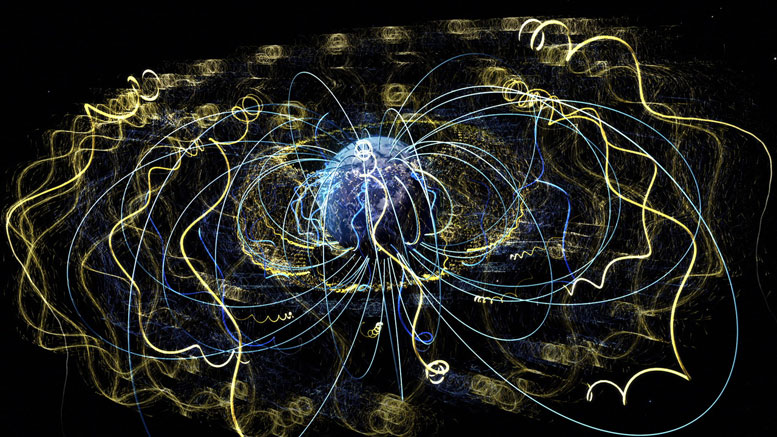Description

Disclaimer: Copyright infringement not intended.
Context
Scientists have detected existence of high-frequency plasma waves in the Martian Upper Atmosphere with novel narrowband and broadband features that can help to understand plasma processes in the Martian plasma environment.
Details
- Plasma waves are oscillations or disturbances that propagate through a plasma medium, which is a state of matter similar to gas but consisting of charged particles—positively charged ions and negatively charged electrons—along with neutral particles.
- These waves play a crucial role in various natural and laboratory plasma phenomena, and their understanding is essential in fields such as astrophysics, plasma physics, and space science.
- Scientists observed high-frequency plasma waves in the Martian plasma environment using data from the MAVEN spacecraft.
- These waves offer insights into plasma processes on Mars, critical due to Mars lacking an intrinsic magnetic field and directly interacting with the solar wind.
Earth's Magnetosphere vs. Mars' Plasma Environment
Earth’s Magnetosphere:
- Plasma Waves Role: Plasma waves in Earth's magnetosphere influence particle energization and movement, impacting the radiation belts.
- Cleaning Agent: Certain waves, like electromagnetic ion cyclotron waves, clean Earth’s radiation belt, safeguarding satellites.
Martian Plasma Environment:
- Absence of Magnetic Field: Mars lacks an inherent magnetic field, leading to direct solar wind interaction with its atmosphere.

Nature of Plasma Waves
Types of Waves:
- Electrostatic Waves: Oscillations arising due to interactions between charged particles in a plasma, mainly driven by electric fields.
- Electromagnetic Waves: Propagate through the plasma and involve both electric and magnetic field variations.
Classification:
- Langmuir Waves: Oscillations driven by the interaction between electrons, often seen in space plasmas and laboratory conditions.
- Alfvén Waves: Result from the interaction between magnetic fields and plasma particles, observed in magnetized plasmas like the solar wind or Earth's magnetosphere.
- Electron Plasma Waves: Propagates through a plasma predominantly due to electron interactions.
- Ion Acoustic Waves: Arise from the interaction between ions and electrons, observed in laboratory plasmas and space environments.
Properties and Characteristics:
Dispersion Relations:
- Frequency-Dispersion Relation: Relationship between wave frequency and wave vector, defining the behavior of waves in a plasma.
- Phase Velocity: Speed at which a phase of a wave propagates in space.
Wave Modes:
- Trapped Modes: Waves confined to specific regions of a plasma due to plasma boundaries or magnetic confinement.
- Resonant Modes: Frequencies at which waves resonate with plasma particles' natural frequencies, enhancing wave-particle interactions.
Generation and Observations:
Natural Sources:
- Solar Plasma: Plasma waves observed in the Sun's corona, solar wind, and flares.
- Magnetospheric Waves: Waves in Earth's magnetosphere, including auroral kilometric radiation and chorus waves.
Laboratory Studies:
- Magnetic Confinement Fusion: Waves generated and controlled to achieve plasma confinement in experimental fusion devices.
- Plasma Diagnostic Tools: Used to study plasma properties, particle energies, and wave-particle interactions.
Significance and Applications:
- Space Weather: Understanding plasma waves' impact on Earth's ionosphere and magnetosphere, crucial for satellite operations and communications.
- Planetary Magnetospheres: Studying waves in other planets' magnetospheres to understand their space environment.
- Magnetic Confinement: Controlling waves to sustain and confine high-temperature plasmas in experimental fusion reactors.
- Plasma Heating: Utilizing waves to heat and control plasma in fusion devices to achieve high temperatures and sustain fusion reactions.
About Plasma
- Plasma is the fourth fundamental state of matter, alongside solids, liquids, and gases.
- It's an ionized gas consisting of positively charged ions and free electrons, exhibiting unique properties and behaviors due to its electrically conductive nature.
Characteristics:
Ionization:
- Plasma is formed when enough energy is applied to a gas, ionizing its atoms and resulting in the liberation of electrons.
- Presence of charged particles: Contains ions, electrons, and neutral particles, exhibiting collective behavior due to electromagnetic forces.
Properties:
- Electric Conductivity: Plasmas conduct electricity due to the presence of free-moving charged particles.
- Self-organization: Plasma responds collectively to external electromagnetic fields, forming structures like filaments and cells.
- Temperature Sensitivity: Wide temperature range, from extremely high temperatures in stars to relatively low temperatures in laboratory plasmas.
Types of Plasmas:
Thermal Plasmas:
- High-temperature plasmas found in stars, fusion reactors, and welding arcs.
- Examples include the solar corona, tokamak fusion reactors, and industrial plasma torches.
Non-Thermal Plasmas:
- Lower-temperature plasmas found in lighting, electronics, and some biomedical applications.
- Examples include fluorescent lights, plasma TVs, and certain medical treatments.
Natural Occurrences:
Astrophysical Plasmas:
- Stellar Plasmas: Constitutes the Sun and stars, involving fusion reactions and high temperatures.
- Galactic Plasmas: Found in interstellar space and galactic cores, influencing cosmic evolution.
Space Plasmas:
- Magnetospheric Plasmas: Surrounds planets like Earth, interacting with solar winds and magnetic fields.
- Solar Wind: Stream of charged particles emitted from the Sun, influencing space weather and planetary atmospheres.
Laboratory and Industrial Applications:
- Utilizing high-temperature plasmas in controlled fusion reactions for energy production, as in tokamak reactors.
- Surface Modification: Plasma-based treatments for altering material properties, improving adhesion, or sterilization.
- Thin Film Deposition: Creating thin films for microelectronics and coatings using plasma-enhanced techniques.
- Understanding space plasma interactions for better prediction and mitigation of space weather effects on technology.

Conclusion
The detection of high-frequency plasma waves in the Martian upper atmosphere offers a unique opportunity to delve deeper into Mars' plasma environment. Understanding the observed waves and their implications for energy dynamics could significantly contribute to our comprehension of Mars’ interaction with solar winds and its unique atmospheric processes. Further research endeavors are essential to unravel the mechanisms behind these detected plasma wave phenomena.
|
PRACTICE QUESTION
Q. Plasma, with its diverse forms and applications, plays a crucial role in natural phenomena, industrial processes, and scientific research. Elaborate. (250 Words)
|










